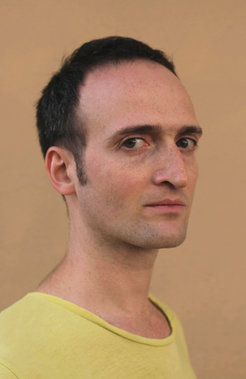Journalists in Residence at the Albert Einstein Institute
In 2018, the Institute started a Journalists-in-Residence program. This program addresses experienced science journalists, staff or freelance, active in any media format: print, blog, radio, podcast, etc. The goal is to strengthen the communication between journalists and scientists and to offer journalists the opportunity to learn more about the institute’s research areas.
Journalists in Residence 2019
Juri Klebanov (stayed May - September, 2019)

"During the period of my residence at the AEI I am working at the development of a new educational media web platform “Visual cores of knowledge”. It is based on the realization that people perceive and comprehend things visually. So, any scientific phenomenon can be explained by dividing it into series of core processes and their representation in form of terse animated loops (“visual cores”). There will be no need for website visitors to know special terms and definitions in order to understand how something works – they will be enabled to understand the phenomenon by mere observation of its “visual cores” and comprehending the visual logics and the visual dynamics of its key processes. “Visual cores” are provided with short comments, however, the comments play only a secondary role and are not indispensable for the understanding. “Visual cores” are, therefore, addressed to anyone who is interested to understand the essence of complicated phenomena in a quick and lucid way.
At AEI I want to create several “visual cores” for different phenomena of gravitation physics and astrophysics. Because of a high complexity of these topics it is very helpful to work on them in a close everyday communication to scientists.”
Juri Klebanov is a physicist, journalist, science popularizer, TV and video director and producer. Over the course of his approximately 20 year career, he has produced hundreds of scientific and educational TV series, explainer videos and stories, that were broadcasted on major national TV channels such as 3sat, WDR, Arte, Pro7, VOX as well as Channel One Russia and NTW Russia.
Dr. Conor P. Purcell (stayed April 27 - May 26, 2019)

"Journalism is all about watching and listening. Throwing yourself into the midst of an environment. For science that means joining researchers as they work in the field or at an institute, in their laboratories and workspaces. You have to see it, watch it, hear it. You have to ask the right questions.
Journalist in Residence programs provide a platform for exactly that. By inviting journalists to spend time with its researchers the Albert Einstein Institute achieves two things. On the one hand the journalist learns from the physicists and may be inspired to produce some work of merit. On the other, the physicists avail of a journalist's knowledge in investigating research and correctly communicating its results, its drawbacks, and its aspirations.
My month here at the institute provided me with the freedom to set and follow my own project, and for that itself to evolve and change as the weeks quickly passed. This kind of freedom is critical for a journalist in a similar way it is to a scientist. The very nature of this kind of creative work requires space to think and breath and to pivot around ideas as new ones come and old ones go. In time many unforeseen realities become apparent.
The freedom I experienced was profound - let motivated people do their work and they will produce. During my stay, in May 2019, I met and interviewed many scientists and enjoyed a high level of professional cooperation. The researchers were interested to have a Journalist in Residence program and during my stay I discussed the profession of science journalism with many interested PhDs and Postdocs. Living on campus also gave me ample evening time to consider what I had learned during the day. It was somehow like a personal retreat.
I wish the institute many more happy years with this program."
Conor Purcell is a science journalist and editor with a PhD in Earth Science. He is a regular contributor of science at The Irish Times, and has also written for Science, New Scientist, Cosmos, The Ecologist, Ars Technica, The Daily Beast, Undark, Horizon and The Sunday Times, amongst others. He writes mostly on climate change, environmental issues, physics, and space, but has also tackled other complex topics including the link between diet and human health. During his career as a researcher he co-authored on a scientific paper published in Nature.
Conor Purcell is also the founding editor of the Wide Orbits community for Ideas, Issues, and Culture. In addition to his work in journalism, he is a private mathematics tutor and musician. He is currently on the Executive Committee of the Irish Science and Technology Journalists' Association (ISTJA).
Blog: cppurcell.tumblr.com
Website: www.wideorbits.com
X: @ConorPPurcell
Mail: purcelcp@tcd.ie
Phone: 00 353 (0)85 188 9599
Articles by Conor Purcell about AEI research and research by AEI alumni:
Heavyweight in the field of gravity research
Q&A: physicist Dr Daniele Oriti, group leader at the Max Planck Institute
The Irish Times, May 30, 2019
What’s inside a black hole? We’re looking into it
Physicist Ana Alonso-Serrano on black holes, wormholes and the multiverse theory
The Irish Times, June 13, 2019
Future Gravitational Wave Detectors Could Find Exoplanets, Too
Although meant to study merging supermassive black holes, the European Space Agency’s LISA mission might also discover hundreds of worlds around white dwarf stars
Scientific American, July 8, 2019
Can we craft a theory in which space and time aren’t assumed to exist?
In some versions of quantum gravity, time itself condenses into existence.
ars technica, April 20, 2020
Could Gravity’s Quantum Origins Explain Dark Energy?
A potentially transformative theoretical study links a new model of quantum gravity with the universe’s bizarrely accelerating rate of expansion
Scientific American, October 28, 2021

